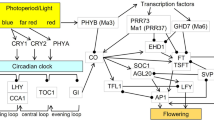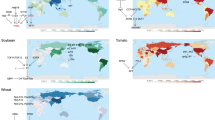Abstract
Profuse and synchronized flowering is a prerequisite for breeding crop plants. Sugarcane, known for its highly variable flowering behavior, requires specific photoperiodic regimes. Repeated experiments in photoperiodic chamber (for 3 years) and field trials (for 2 years) were attempted to standardize the physiological interventions required for induction of flowering as well as its synchronization. Flowering was induced in 36 out of 46 clones treated in the photoperiodic chamber with two sets of treatments, commencing with a photoperiod of either 12 h 45 min or 12 h 55 min, followed by declining day length at the rate of 60 s day−1 for 85 and 75 cycles, respectively. Histological studies indicated conversion of vegetative to reproductive bud due to photoperiodic treatments, while temperature was a determining factor for panicle emergence or reversion to vegetative state. In the field trials, night interruption (with lighting for a period of 30 days) followed by post-inductive constant photoperiod of 12 h 40 min delayed flowering by a minimum of 4 days up to 39 days. These experiments confirmed that sugarcane flowering may be manipulated through photoperiodic treatments for the successful hybridization of desired parental clones in breeding programs.


Similar content being viewed by others
References
Abou-Salama. 1990. Sugarcane pollen viability and seed setting as affected by day length decline rates and relative humidity. Dissertation: Louisiana State University.
Ahmed, M.F., M. Siddique, N. Kamal, and N. Ahmad. 2019. Sugarcane flowering at sugarcane breeding substation (SBSS). Murree Haya Saudi Journal of Life Sciences 4 (206): 212.
Berding, N. 1981. Improved pollen fertility in sugarcane under increased night temperature. Crop Science 21: 863–867.
Berding, N., V. Dunne, R.S. Swain, and W.G. Owens. 2004. Tropical managed initiation of sugarcane flowering. Optimization of non-photoperiodic variables. Proceedings of the Australian Society of Sugar Cane Technologists 26: 13.
Brett, P.G.C., and R.L. Harding. 1974. Artificial induction of flowering in Natal. Proceedings of the International Society of Sugar Cane Technologists 15: 55–66.
Chilton, S.J.P., and E.D. Paliatseas. 1956. Studies on the flowering of sugarcane. Proceedings of the International Society of Sugar Cane Technologists 9: 652–656.
Coleman, R.E. 1963. Effect of temperature on flowering of sugarcane. International Sugar Journal 65: 351–353.
Dunckelman, P.H., and B.L. Legendre. 1982. Guide to sugarcane breeding in the temperate zone. Agricultural Reviews and Manuals 22: 1–26.
Edwards, E., and J.G. Paxton. 1979. Effects of photoperiod and temperature on the rate of elongation of sugarcane leaf sheaths. Proceedings of the South African Sugar Technologists Association 53: 163–164.
Gomez, K.A., and A.A. Gomez. 1984. Statistical procedures for agricultural research. New York: John Wiley and Sons.
Hemaprabha, G., S. Alarmelu, K. Mohanraj, C. Mahadevaiah, V. Raffee Viola, and B Ram. 2018a. Morphological description of Coimbatore (Co) canes (1993–2016). ICAR-Sugarcane Breeding Institute, Coimbatore.
Hemaprabha, G., S. Alarmelu, R.M. Shanthi, and B. Ram. 2018b. Database of Coimbatore canes (1918–2017). ICAR-Sugarcane Breeding Institute, Coimbatore.
Heslop-Harrison, Y., and J. Heslop-Harrison. 1992. Germination of monocolpate angiosperm pollen: Evolution of the actin cytoskeleton and wall during hydration, activation and tube emergence. Annals of Botany 69: 385–394.
James, N.I., and J.D. Miller. 1971. Shoot apex development in early-mid-and late-season flowering sugarcane clones. Proceedings of the International Society of Sugar Cane Technologists 14: 334–340.
Johansen, D.A. 1940. Plant microtechnique. New York: McGraw-Hill Book Co.
LaBorde, C.M., C. Kimberg, K. Gravois, and K. Bischoff. 2014. Temperature effects on sugarcane tassel production under artificial photoperiod regimes. Journal of American Society of Sugar Cane Technologists 34: 33–43.
LaBorde, C.M. 2007. Sugarcane tasseling under artificial photoperiod conditions as affected by nitrogen rate and temperature. Dissertation: Louisiana State University.
Li, W., Y. Yong, Y. Zhang, and Y. Lyu. 2019. Transcriptional regulatory network of GA floral induction pathway in LA hybrid lily. International Journal of Molecular Sciences 20 (11): 2694.
Mehareb Eid, M., W.E. Grad, and F.M. Fouz Abo Elenen. 2021. Flowering performance of sugarcane genotypes under natural and artificial conditions. Direct Research Journal of Agriculture and Food Sciences 9: 113–120.
Melloni, M.L.G., M.N.G. Melloni, M.S. Scarpari, J.C. Garcia, M.G.A. Landell, and L.R. Pinto. 2015. Flowering of sugarcane genotypes under different artificial photoperiod conditions. American Journal of Plant Science 6: 456–463.
Midmore, D.J. 1980. Effects of photoperiod on flowering and fertility of sugarcane (Saccharum spp.). Field Crops Research 3: 65–81.
Moore, P.H., and N. Berding. 2014. Flowering. In Sugarcane: Physiology, biochemistry and functional biology, ed. P.H. Moore and F.C. Botha, 379–410. London: Wiley Blackwell.
Moore, P.H., R.P. Pharis, and M. Koshioka. 1986. Gibberellins in apical shoot meristems of flowering and vegetative sugarcane. Journal of Plant Growth Regulation 5: 101–109.
Noguchi, Y., T. Nakajima, and T. Yamaguchi. 1967. Studies on the control of flower bud formation by temperature and daylength in rice plants. VII. Elimination of photoinductive effects by keeping under long day conditions. Japanese Journal of Breeding 17: 20–24.
Nuss, K.J. 1978. Synchronization of flowering to implement a proven cross breeding system in sugarcane. Proceedings of the International Society of Sugar Cane Technologists 16: 111–119.
Nuss, K.J. 1980. Effects of photoperiod and temperature on initiation and development of flowers in sugarcane. Proceedings of the International Society of Sugar Cane Technologists 17: 486–493.
Nuss, K.J., and P.G.C. Brett. 1977. Artificial induction of flowering in a sugarcane breeding programme. Proceedings of the South African Genetics Society 6: 54–64.
O’Brien, T.P., N. Feder, and M.E. McColl. 1964. Polychromatic staining of plant cell walls by toluidine blue O. Protoplasma 59: 367–373.
Rajkumar, R., S. Marimuthu, and L. Manivel. 1996. A method to assess the endogenous abscisic acid and gibberellic acid like substances in tea. In: Placrosym-XII. India: UPASI Tea Research Institute.
Rao, J.T., and Vijayalakshmi. 1964. Improved canes in cultivation. The Indian Central Sugarcane Committee, New Delhi.
Rathod, V., T.K. Behera, A.D. Munshi, K. Durgesh, G.S. Jat, B.G. Krishnan, and N. Sharma. 2018. Pollen viability and in vitro pollen germination studies in Momordica species and their intra and interspecific hybrids. International Journal of Chemical Studies 6 (6): 32–40.
Roach, B.T. 1978. Adjustment of flowering time in a practical cane breeding program. Sugarcane Breeding Newsletter 41: 1–3.
Sankaranarayanan, P., B.V. Natarajan, and S. Marimuthammal. 1980. Sugarcane varieties under cultivation in India: their morphological description and agricultural characteristics. Indian Council of Agricultural Research, New Delhi.
Sass, J.E. 1940. Elements of botanical micro technique. New York: McGraw-Hill Book Co.
Shanmugavadivu, R., and P.N.G. Rao. 2009a. A comparison of flowering behaviour of sugarcane clones in two different locations. Sugar Tech 11 (4): 401–404.
Shanmugavadivu, R., and P.N.G. Rao. 2009b. Endogenous gibberellin level in the shoot apices of flowered and non-flowered stalks of sugarcane varieties. Indian Journal of Plant Physiology 14 (3): 303–305.
Sreenivasan, T.V., and K.V. Bhagyalakshmi. 2001. Morphological description of improved Coimbatore cane selections (1985–1992). ICAR-Sugarcane Breeding Institute, Coimbatore.
Vergara, B.S., and R. Lilis. 1968. Responses of the rice plant to photoperiod. IV. Effect of different photoperiods after panicle initiation on the emergence of panicle. Philippine Agriculture 52: 61–65.
Vijayasaradhy, M., and R. Narasimhan. 1954. Control of flowering of sugarcane. Proceedings of the International Society of Sugar Cane Technologists 8: 371–401.
Walker, D.I.T., D. MacColl, and P.S. Rao. 1978. Aspects of the use of Saccharum spontaneum in the West Indies programme. Proceedings of the International Society of Sugar Cane Technologists 16: 291–303.
Acknowledgements
The authors are thankful to the Director, ICAR-SBI, for providing the infrastructural facilities, support and encouragement to pursue the work on photoperiodic induction of flowering in sugarcane.
Author information
Authors and Affiliations
Contributions
VS contributed to conceptualization, AKR and KV contributed to formal analysis, BR provided resources, KV, VS, AKR and AST contributed to writing—review and editing. All authors have read and agreed to the published version of the manuscript.
Corresponding author
Ethics declarations
Conflicts of interest
The authors declare no conflict of interest.
Additional information
Publisher's Note
Springer Nature remains neutral with regard to jurisdictional claims in published maps and institutional affiliations.
Supplementary Information
Below is the link to the electronic supplementary material.
Rights and permissions
About this article
Cite this article
Vengavasi, K., Srinivasavedantham, V., Raja, A.K. et al. Photoperiodic Induction and Synchronization of Flowering in Sugarcane Hybrids for Breeding Programs. Sugar Tech 25, 160–167 (2023). https://doi.org/10.1007/s12355-022-01164-w
Received:
Accepted:
Published:
Issue Date:
DOI: https://doi.org/10.1007/s12355-022-01164-w




